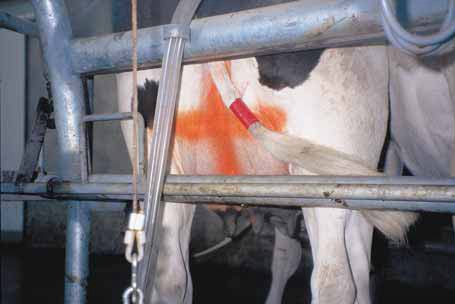Lactating cows
Follow instructions
Before administering antibiotics to an animal, it is essential that you read the details on the label. It is important to make sure that the:
- drug is appropriate for the ailment
- drug is administered via the recommended route;
- intramuscular — directly into the muscle
- intravenous — into a vein
- intramammary — into the teat
- intrauterine — into the uterus
- correct dosage is given at the right frequency
- withholding period is noted and recorded every time a drug is used — never assume that two similar types of antibiotics have the same withholding time.
The withholding period stated on the label is only valid when all instructions are followed correctly. For example, if an antibiotic with a labelled dose of 20mL is administered at a dose of 30mL, the stated withholding period will no longer apply. As the withholding period is unknown, there is a risk that the animal will be milked too early and her milk will contaminate the whole vat. If you are unsure, have the milk tested by your factory field officer before it enters the vat.
Clearly identify treated cows
If a lactating animal is treated with antibiotics, she must be clearly identified. Use a combination of identification methods to ensure the cow is not missed if one method fails.
Dairy farmers in Western Australia have tried and tested many methods to identify treated cows effectively. The most successful of these are simple methods that rely on awareness, common sense and a splash of colour!
Spray paint
Brightly coloured spray paint across the udder and legs of the treated animal provides clear identification to the milker. The paint can be washed off or sprayed over with a different colour once the withholding period has ended. Some farmers use the ‘stop/go’ method — red paint for ‘stop’ and green for ‘go’. Take extra care in winter as heavy rain may wash the paint away. The use of tail paint across the udder is not recommended as it is very difficult to remove once the withholding period has ended.
Tape on tail and legs
A wide band of coloured tape on the tail and legs is also effective identification, particularly when used with the spray paint method. The tape must be wrapped securely and should be visible during milking; position tape on the tail so it is not hidden behind the splashguard.

Ankle straps
Velcro ankle straps are convenient because they can be quickly and easily attached to the ankle after treatment. Unfortunately, this feature also makes them more likely to come off in the paddock, laneway or yard. Brightly coloured ankle straps are best used with one of the more reliable methods mentioned above.
Isolate treated cows
If possible, isolation of the treated animal(s) is the most effective way to prevent antibiotic contamination of the vat. This can be done in several ways:
- Run the treated animal(s) as a separate ‘hospital’ herd and milk them after the milkline has been removed from the vat. This is the most reliable option but only would be practical in large herds where there are two or more milkers.
- Keep the cow with the main herd but draft her out prior to milking and milk her last.
- If the treated cow cannot be isolated and she is milked into a test bucket, the cluster used should be flushed out with clean water before it is applied to the next cow. This has proven to be the least reliable method of the three. Lack of concentration on the part of the milker often leads to its failure.
Keep records
Good records enable you to keep track of what has happened in the herd and are also an important means of communication.
White/black board
A white/black board in the dairy allows you to record instructions and cow treatment details where everyone can see them. Many farmers use these boards to record:
- an explanation of the identification system used, cow number and quarter treated
- date and time (am/pm) treated; withholding period
- the date milk is due to re-enter the vat and consecutive treatments on the same animal.
Dairy book
Recording the white/black board information into the dairy book will give you a permanent set of treatment records. These records should prove useful as a tool for identifying problem cows and a backup for the white/black board information.
Make your milkers aware
If you have treated a cow with antibiotics and someone else — for example relief milker, family member, etc — will be milking, make sure they know how and why the animal is marked by:
- telling them
- leaving a detailed note in the dairy
- writing details on the dairy white board where they can be clearly seen.
This also applies to regular milkers — do not assume that your workers know how the system works if you have not explained it. Make sure they understand the markings on the animal, the information on the white board and the importance of keeping antibiotic residues out of the vat.
Choose the right test bucket
If a treated cow is to be milked into a test bucket, ensure that the bucket is big enough to hold all the milk she will produce at that milking. If two or more cows require the test bucket, empty the bucket between cows. Take extra care when operating around the test bucket while it is in use. If everyone in the pit is aware of where the test bucket is, it is less likely to get knocked over. Where possible, the test bucket can be secured by the use of clips, hooks, rigid hoses, etc.
